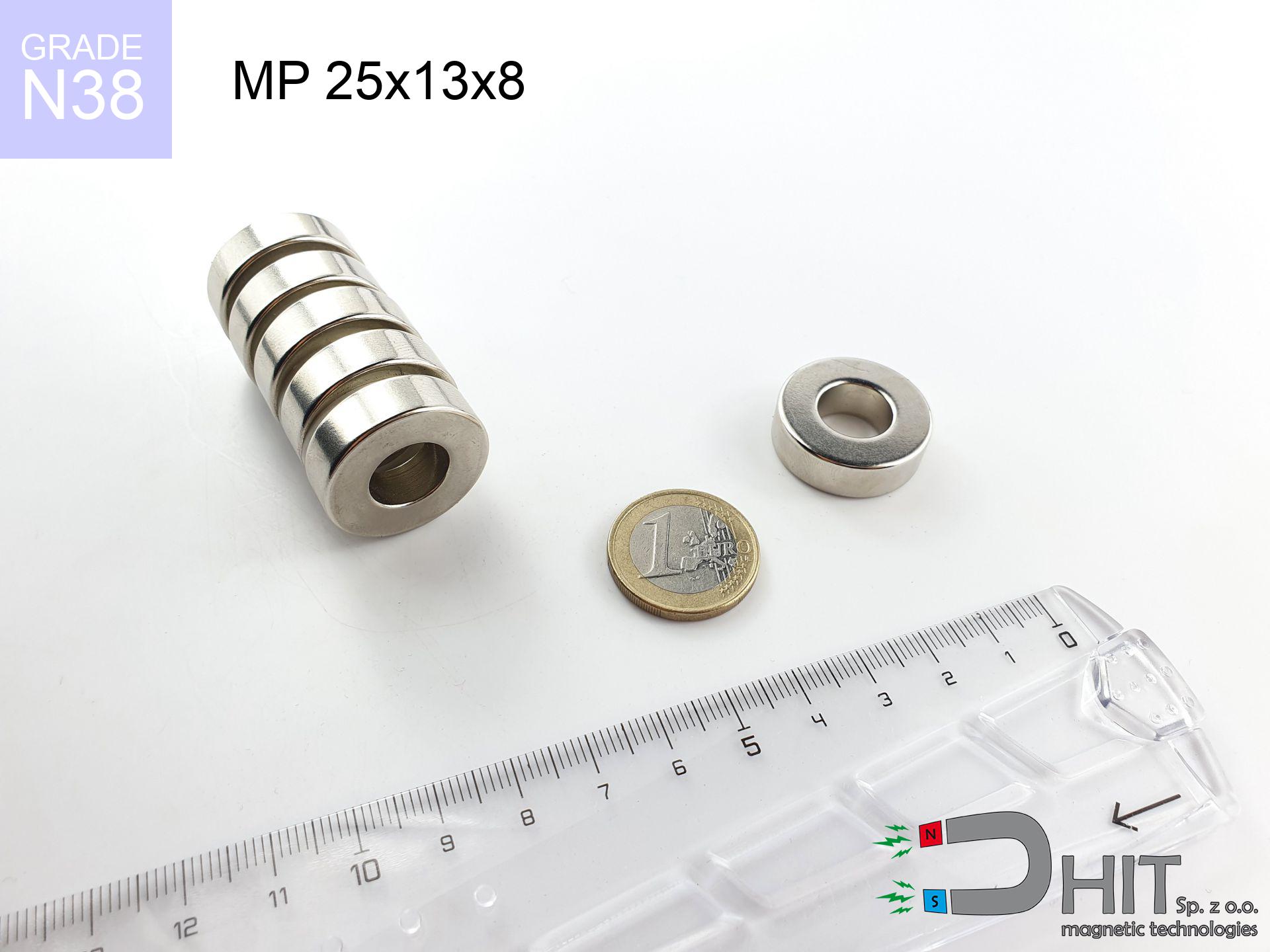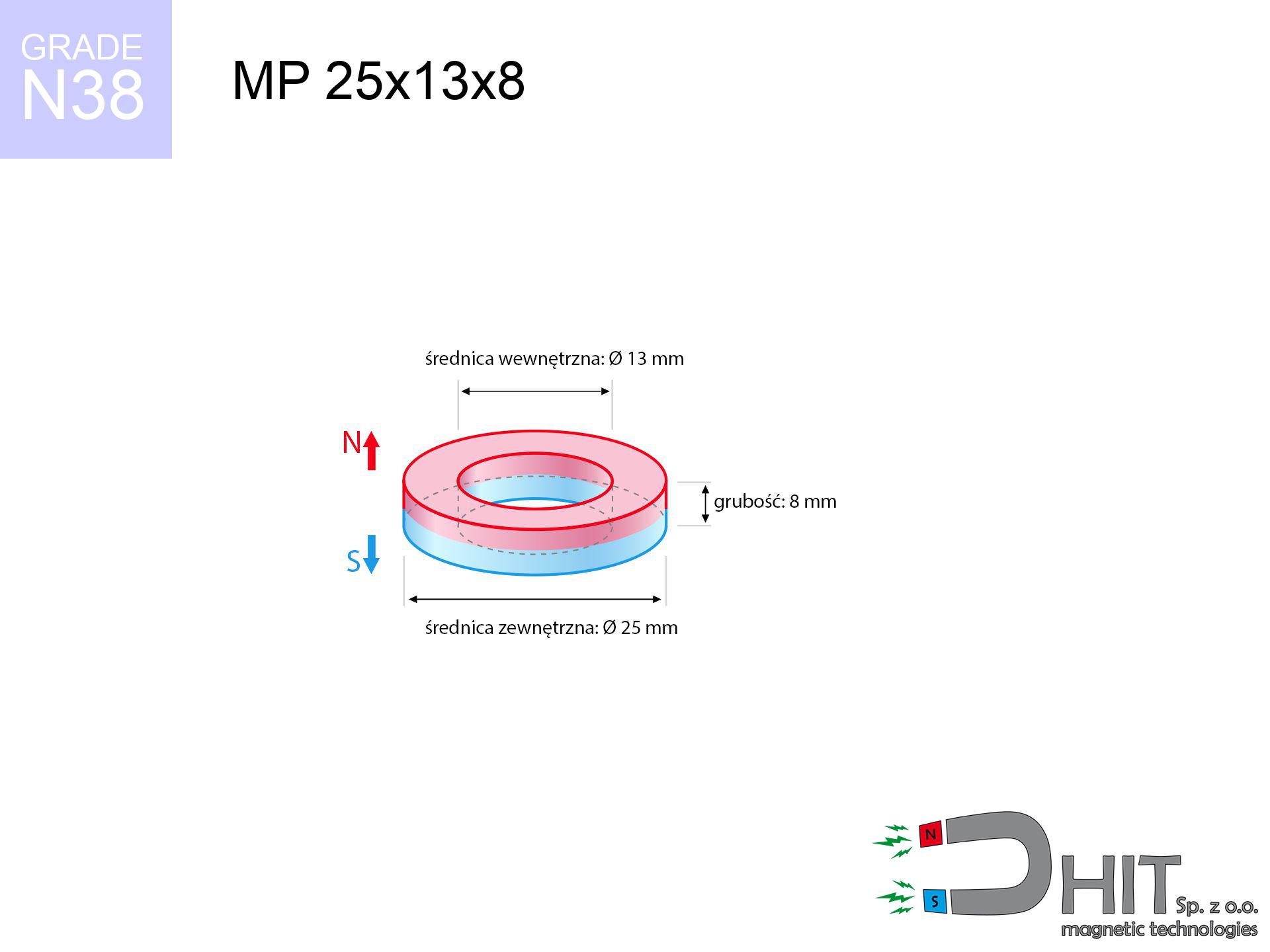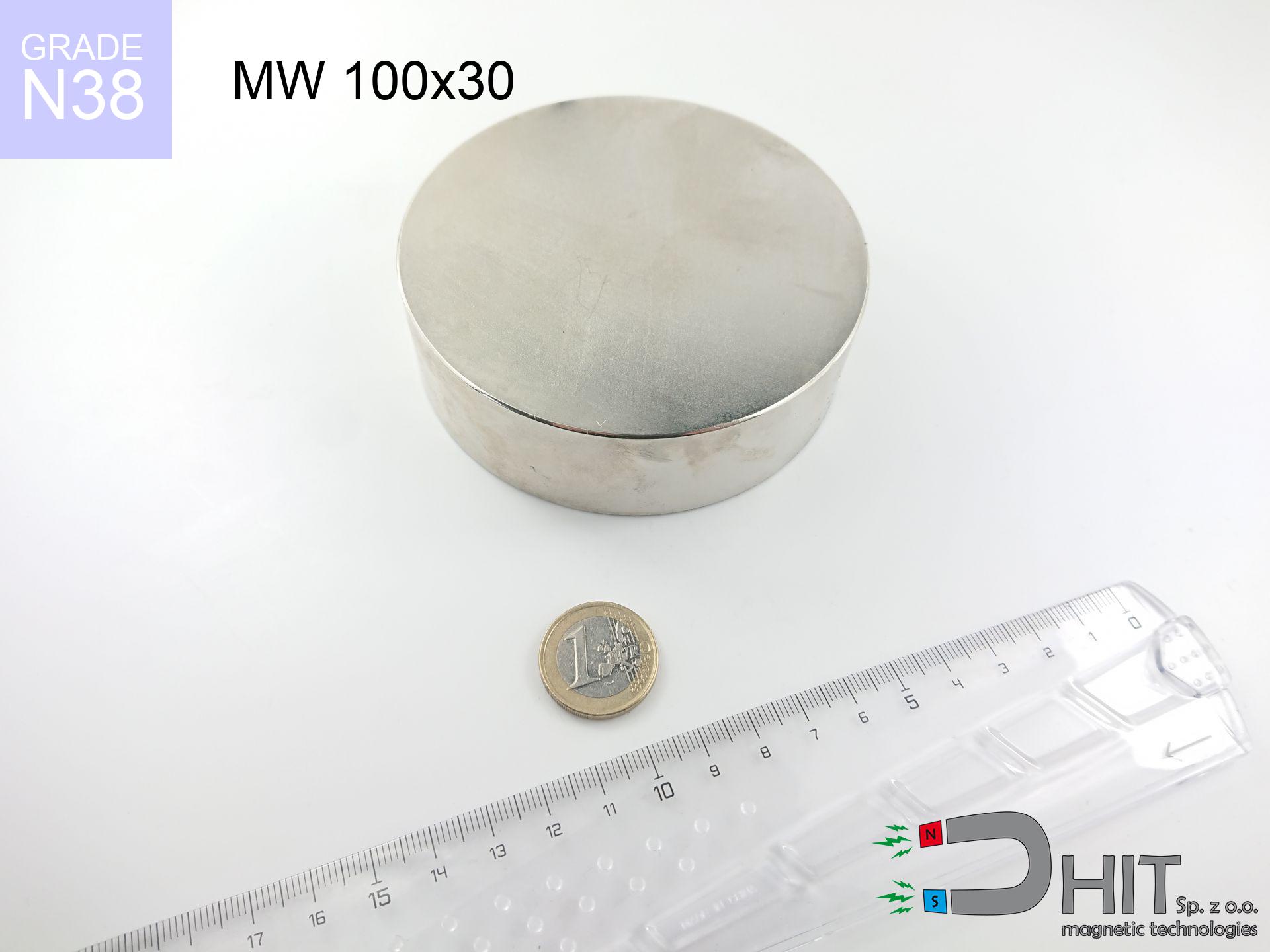MP 25x13x8 / N38 - ring magnet
ring magnet
Catalog no 030191
GTIN/EAN: 5906301812081
Diameter
25 mm [±0,1 mm]
internal diameter Ø
13 mm [±0,1 mm]
Height
8 mm [±0,1 mm]
Weight
21.49 g
Magnetization Direction
↑ axial
Load capacity
10.49 kg / 102.90 N
Magnetic Induction
334.09 mT / 3341 Gs
Coating
[NiCuNi] Nickel
13.53 ZŁ with VAT / pcs + price for transport
11.00 ZŁ net + 23% VAT / pcs
bulk discounts:
Need more?Want to talk magnets?
Give us a call
+48 888 99 98 98
alternatively contact us by means of
request form
the contact page.
Strength along with form of a neodymium magnet can be estimated with our
online calculation tool.
Order by 14:00 and we’ll ship today!
MP 25x13x8 / N38 - ring magnet
Specification / characteristics MP 25x13x8 / N38 - ring magnet
| properties | values |
|---|---|
| Cat. no. | 030191 |
| GTIN/EAN | 5906301812081 |
| Production/Distribution | Dhit sp. z o.o. |
| Country of origin | Poland / China / Germany |
| Customs code | 85059029 |
| Diameter | 25 mm [±0,1 mm] |
| internal diameter Ø | 13 mm [±0,1 mm] |
| Height | 8 mm [±0,1 mm] |
| Weight | 21.49 g |
| Magnetization Direction | ↑ axial |
| Load capacity ~ ? | 10.49 kg / 102.90 N |
| Magnetic Induction ~ ? | 334.09 mT / 3341 Gs |
| Coating | [NiCuNi] Nickel |
| Manufacturing Tolerance | ±0.1 mm |
Magnetic properties of material N38
| properties | values | units |
|---|---|---|
| remenance Br [min. - max.] ? | 12.2-12.6 | kGs |
| remenance Br [min. - max.] ? | 1220-1260 | mT |
| coercivity bHc ? | 10.8-11.5 | kOe |
| coercivity bHc ? | 860-915 | kA/m |
| actual internal force iHc | ≥ 12 | kOe |
| actual internal force iHc | ≥ 955 | kA/m |
| energy density [min. - max.] ? | 36-38 | BH max MGOe |
| energy density [min. - max.] ? | 287-303 | BH max KJ/m |
| max. temperature ? | ≤ 80 | °C |
Physical properties of sintered neodymium magnets Nd2Fe14B at 20°C
| properties | values | units |
|---|---|---|
| Vickers hardness | ≥550 | Hv |
| Density | ≥7.4 | g/cm3 |
| Curie Temperature TC | 312 - 380 | °C |
| Curie Temperature TF | 593 - 716 | °F |
| Specific resistance | 150 | μΩ⋅cm |
| Bending strength | 250 | MPa |
| Compressive strength | 1000~1100 | MPa |
| Thermal expansion parallel (∥) to orientation (M) | (3-4) x 10-6 | °C-1 |
| Thermal expansion perpendicular (⊥) to orientation (M) | -(1-3) x 10-6 | °C-1 |
| Young's modulus | 1.7 x 104 | kg/mm² |
Engineering analysis of the assembly - report
Presented data are the outcome of a physical calculation. Values rely on algorithms for the material Nd2Fe14B. Operational performance might slightly differ. Please consider these calculations as a reference point when designing systems.
MP 25x13x8 / N38
| Distance (mm) | Induction (Gauss) / mT | Pull Force (kg) | Risk Status |
|---|---|---|---|
| 0 mm |
5777 Gs
577.7 mT
|
10.49 kg / 10490.0 g
102.9 N
|
crushing |
| 1 mm |
5310 Gs
531.0 mT
|
8.86 kg / 8861.7 g
86.9 N
|
medium risk |
| 2 mm |
4846 Gs
484.6 mT
|
7.38 kg / 7379.4 g
72.4 N
|
medium risk |
| 3 mm |
4397 Gs
439.7 mT
|
6.08 kg / 6077.4 g
59.6 N
|
medium risk |
| 5 mm |
3576 Gs
357.6 mT
|
4.02 kg / 4019.0 g
39.4 N
|
medium risk |
| 10 mm |
2073 Gs
207.3 mT
|
1.35 kg / 1350.2 g
13.2 N
|
weak grip |
| 15 mm |
1231 Gs
123.1 mT
|
0.48 kg / 476.4 g
4.7 N
|
weak grip |
| 20 mm |
773 Gs
77.3 mT
|
0.19 kg / 187.6 g
1.8 N
|
weak grip |
| 30 mm |
356 Gs
35.6 mT
|
0.04 kg / 39.8 g
0.4 N
|
weak grip |
| 50 mm |
115 Gs
11.5 mT
|
0.00 kg / 4.1 g
0.0 N
|
weak grip |
MP 25x13x8 / N38
| Distance (mm) | Friction coefficient | Pull Force (kg) |
|---|---|---|
| 0 mm | Stal (~0.2) |
2.10 kg / 2098.0 g
20.6 N
|
| 1 mm | Stal (~0.2) |
1.77 kg / 1772.0 g
17.4 N
|
| 2 mm | Stal (~0.2) |
1.48 kg / 1476.0 g
14.5 N
|
| 3 mm | Stal (~0.2) |
1.22 kg / 1216.0 g
11.9 N
|
| 5 mm | Stal (~0.2) |
0.80 kg / 804.0 g
7.9 N
|
| 10 mm | Stal (~0.2) |
0.27 kg / 270.0 g
2.6 N
|
| 15 mm | Stal (~0.2) |
0.10 kg / 96.0 g
0.9 N
|
| 20 mm | Stal (~0.2) |
0.04 kg / 38.0 g
0.4 N
|
| 30 mm | Stal (~0.2) |
0.01 kg / 8.0 g
0.1 N
|
| 50 mm | Stal (~0.2) |
0.00 kg / 0.0 g
0.0 N
|
MP 25x13x8 / N38
| Surface type | Friction coefficient / % Mocy | Max load (kg) |
|---|---|---|
| Raw steel |
µ = 0.3
30% Nominalnej Siły
|
3.15 kg / 3147.0 g
30.9 N
|
| Painted steel (standard) |
µ = 0.2
20% Nominalnej Siły
|
2.10 kg / 2098.0 g
20.6 N
|
| Oily/slippery steel |
µ = 0.1
10% Nominalnej Siły
|
1.05 kg / 1049.0 g
10.3 N
|
| Magnet with anti-slip rubber |
µ = 0.5
50% Nominalnej Siły
|
5.25 kg / 5245.0 g
51.5 N
|
MP 25x13x8 / N38
| Steel thickness (mm) | % power | Real pull force (kg) |
|---|---|---|
| 0.5 mm |
|
0.52 kg / 524.5 g
5.1 N
|
| 1 mm |
|
1.31 kg / 1311.3 g
12.9 N
|
| 2 mm |
|
2.62 kg / 2622.5 g
25.7 N
|
| 5 mm |
|
6.56 kg / 6556.3 g
64.3 N
|
| 10 mm |
|
10.49 kg / 10490.0 g
102.9 N
|
MP 25x13x8 / N38
| Ambient temp. (°C) | Power loss | Remaining pull | Status |
|---|---|---|---|
| 20 °C | 0.0% |
10.49 kg / 10490.0 g
102.9 N
|
OK |
| 40 °C | -2.2% |
10.26 kg / 10259.2 g
100.6 N
|
OK |
| 60 °C | -4.4% |
10.03 kg / 10028.4 g
98.4 N
|
OK |
| 80 °C | -6.6% |
9.80 kg / 9797.7 g
96.1 N
|
|
| 100 °C | -28.8% |
7.47 kg / 7468.9 g
73.3 N
|
MP 25x13x8 / N38
| Gap (mm) | Attraction (kg) (N-S) | Repulsion (kg) (N-N) |
|---|---|---|
| 0 mm |
77.07 kg / 77067 g
756.0 N
6 082 Gs
|
N/A |
| 1 mm |
71.01 kg / 71011 g
696.6 N
11 091 Gs
|
63.91 kg / 63910 g
627.0 N
~0 Gs
|
| 2 mm |
65.10 kg / 65105 g
638.7 N
10 620 Gs
|
58.59 kg / 58594 g
574.8 N
~0 Gs
|
| 3 mm |
59.50 kg / 59500 g
583.7 N
10 153 Gs
|
53.55 kg / 53550 g
525.3 N
~0 Gs
|
| 5 mm |
49.26 kg / 49263 g
483.3 N
9 238 Gs
|
44.34 kg / 44336 g
434.9 N
~0 Gs
|
| 10 mm |
29.53 kg / 29527 g
289.7 N
7 152 Gs
|
26.57 kg / 26574 g
260.7 N
~0 Gs
|
| 20 mm |
9.92 kg / 9919 g
97.3 N
4 145 Gs
|
8.93 kg / 8927 g
87.6 N
~0 Gs
|
| 50 mm |
0.61 kg / 605 g
5.9 N
1 024 Gs
|
0.54 kg / 545 g
5.3 N
~0 Gs
|
MP 25x13x8 / N38
| Object / Device | Limit (Gauss) / mT | Safe distance |
|---|---|---|
| Pacemaker | 5 Gs (0.5 mT) | 17.0 cm |
| Hearing aid | 10 Gs (1.0 mT) | 13.5 cm |
| Mechanical watch | 20 Gs (2.0 mT) | 10.5 cm |
| Mobile device | 40 Gs (4.0 mT) | 8.0 cm |
| Remote | 50 Gs (5.0 mT) | 7.5 cm |
| Payment card | 400 Gs (40.0 mT) | 3.0 cm |
| HDD hard drive | 600 Gs (60.0 mT) | 2.5 cm |
MP 25x13x8 / N38
| Start from (mm) | Speed (km/h) | Energy (J) | Predicted outcome |
|---|---|---|---|
| 10 mm |
24.01 km/h
(6.67 m/s)
|
0.48 J | |
| 30 mm |
38.68 km/h
(10.75 m/s)
|
1.24 J | |
| 50 mm |
49.84 km/h
(13.84 m/s)
|
2.06 J | |
| 100 mm |
70.46 km/h
(19.57 m/s)
|
4.12 J |
MP 25x13x8 / N38
| Technical parameter | Value / Description |
|---|---|
| Coating type | [NiCuNi] Nickel |
| Layer structure | Nickel - Copper - Nickel |
| Layer thickness | 10-20 µm |
| Salt spray test (SST) ? | 24 h |
| Recommended environment | Indoors only (dry) |
MP 25x13x8 / N38
| Parameter | Value | SI Unit / Description |
|---|---|---|
| Magnetic Flux | 23 118 Mx | 231.2 µWb |
| Pc Coefficient | 1.04 | High (Stable) |
MP 25x13x8 / N38
| Environment | Effective steel pull | Effect |
|---|---|---|
| Air (land) | 10.49 kg | Standard |
| Water (riverbed) |
12.01 kg
(+1.52 kg Buoyancy gain)
|
+14.5% |
1. Shear force
*Warning: On a vertical surface, the magnet holds just a fraction of its max power.
2. Steel saturation
*Thin metal sheet (e.g. 0.5mm PC case) drastically limits the holding force.
3. Thermal stability
*For N38 material, the critical limit is 80°C.
4. Demagnetization curve and operating point (B-H)
chart generated for the permeance coefficient Pc (Permeance Coefficient) = 1.04
This simulation demonstrates the magnetic stability of the selected magnet under specific geometric conditions. The solid red line represents the demagnetization curve (material potential), while the dashed blue line is the load line based on the magnet's geometry. The Pc (Permeance Coefficient), also known as the load line slope, is a dimensionless value that describes the relationship between the magnet's shape and its magnetic stability. The intersection of these two lines (the black dot) is the operating point — it determines the actual magnetic flux density generated by the magnet in this specific configuration. A higher Pc value means the magnet is more 'slender' (tall relative to its area), resulting in a higher operating point and better resistance to irreversible demagnetization caused by external fields or temperature. A value of 0.42 is relatively low (typical for flat magnets), meaning the operating point is closer to the 'knee' of the curve — caution is advised when operating at temperatures near the maximum limit to avoid strength loss.
Chemical composition
| iron (Fe) | 64% – 68% |
| neodymium (Nd) | 29% – 32% |
| boron (B) | 1.1% – 1.2% |
| dysprosium (Dy) | 0.5% – 2.0% |
| coating (Ni-Cu-Ni) | < 0.05% |
Sustainability
| recyclability (EoL) | 100% |
| recycled raw materials | ~10% (pre-cons) |
| carbon footprint | low / zredukowany |
| waste code (EWC) | 16 02 16 |
Check out more deals
Pros and cons of rare earth magnets.
Strengths
- They virtually do not lose strength, because even after 10 years the performance loss is only ~1% (based on calculations),
- Magnets effectively defend themselves against loss of magnetization caused by external fields,
- In other words, due to the smooth finish of nickel, the element is aesthetically pleasing,
- They are known for high magnetic induction at the operating surface, which affects their effectiveness,
- Due to their durability and thermal resistance, neodymium magnets can operate (depending on the form) even at high temperatures reaching 230°C or more...
- Thanks to the possibility of accurate shaping and adaptation to custom projects, magnetic components can be manufactured in a variety of geometric configurations, which expands the range of possible applications,
- Significant place in advanced technology sectors – they are used in HDD drives, electric drive systems, medical devices, and multitasking production systems.
- Relatively small size with high pulling force – neodymium magnets offer high power in small dimensions, which allows their use in compact constructions
Disadvantages
- At strong impacts they can break, therefore we recommend placing them in special holders. A metal housing provides additional protection against damage, as well as increases the magnet's durability.
- When exposed to high temperature, neodymium magnets experience a drop in force. Often, when the temperature exceeds 80°C, their power decreases (depending on the size, as well as shape of the magnet). For those who need magnets for extreme conditions, we offer [AH] versions withstanding up to 230°C
- When exposed to humidity, magnets usually rust. For applications outside, it is recommended to use protective magnets, such as magnets in rubber or plastics, which secure oxidation and corrosion.
- Limited ability of making nuts in the magnet and complex forms - recommended is a housing - mounting mechanism.
- Possible danger to health – tiny shards of magnets pose a threat, if swallowed, which is particularly important in the aspect of protecting the youngest. Additionally, small components of these products can complicate diagnosis medical when they are in the body.
- Higher cost of purchase is one of the disadvantages compared to ceramic magnets, especially in budget applications
Holding force characteristics
Magnetic strength at its maximum – what it depends on?
- using a plate made of high-permeability steel, serving as a ideal flux conductor
- possessing a thickness of minimum 10 mm to ensure full flux closure
- characterized by smoothness
- without the slightest insulating layer between the magnet and steel
- under perpendicular application of breakaway force (90-degree angle)
- in temp. approx. 20°C
Magnet lifting force in use – key factors
- Space between surfaces – even a fraction of a millimeter of distance (caused e.g. by varnish or dirt) diminishes the pulling force, often by half at just 0.5 mm.
- Loading method – catalog parameter refers to pulling vertically. When attempting to slide, the magnet exhibits significantly lower power (typically approx. 20-30% of maximum force).
- Substrate thickness – for full efficiency, the steel must be adequately massive. Paper-thin metal limits the lifting capacity (the magnet "punches through" it).
- Plate material – mild steel gives the best results. Higher carbon content lower magnetic permeability and holding force.
- Surface condition – ground elements ensure maximum contact, which increases force. Rough surfaces weaken the grip.
- Temperature influence – hot environment reduces pulling force. Too high temperature can permanently damage the magnet.
Holding force was checked on the plate surface of 20 mm thickness, when a perpendicular force was applied, in contrast under attempts to slide the magnet the holding force is lower. Moreover, even a slight gap between the magnet and the plate decreases the lifting capacity.
Safe distance
Powerful magnetic fields can destroy records on payment cards, HDDs, and other magnetic media. Maintain a gap of at least 10 cm.
Pacemakers
Warning for patients: Strong magnetic fields affect medical devices. Keep minimum 30 cm distance or ask another person to handle the magnets.
Fire risk
Machining of neodymium magnets poses a fire risk. Magnetic powder oxidizes rapidly with oxygen and is hard to extinguish.
Magnet fragility
Neodymium magnets are sintered ceramics, meaning they are prone to chipping. Impact of two magnets will cause them shattering into small pieces.
Danger to the youngest
Strictly store magnets out of reach of children. Ingestion danger is high, and the consequences of magnets connecting inside the body are tragic.
Allergy Warning
Some people have a hypersensitivity to nickel, which is the typical protective layer for neodymium magnets. Extended handling can result in skin redness. It is best to use safety gloves.
Keep away from electronics
A strong magnetic field interferes with the functioning of magnetometers in smartphones and navigation systems. Keep magnets close to a smartphone to prevent breaking the sensors.
Immense force
Use magnets consciously. Their immense force can surprise even experienced users. Stay alert and respect their power.
Crushing risk
Large magnets can break fingers instantly. Under no circumstances put your hand between two attracting surfaces.
Operating temperature
Keep cool. NdFeB magnets are susceptible to heat. If you need resistance above 80°C, inquire about HT versions (H, SH, UH).




![UMGGW 88x8.5 [M6] GW / N38 - magnetic holder rubber internal thread UMGGW 88x8.5 [M6] GW / N38 - magnetic holder rubber internal thread](https://cdn3.dhit.pl/graphics/products/umg-88x8.5-m8-gw-let.jpg)


![SM 18x125 [2xM5] / N42 - magnetic separator SM 18x125 [2xM5] / N42 - magnetic separator](https://cdn3.dhit.pl/graphics/products/sm-18x125-2xm5-cij.jpg)

